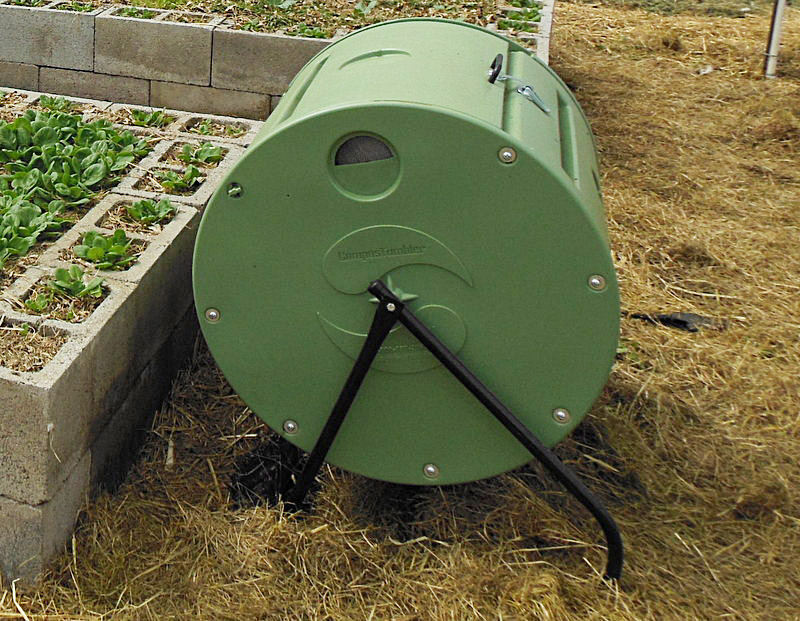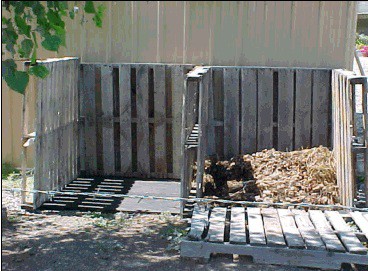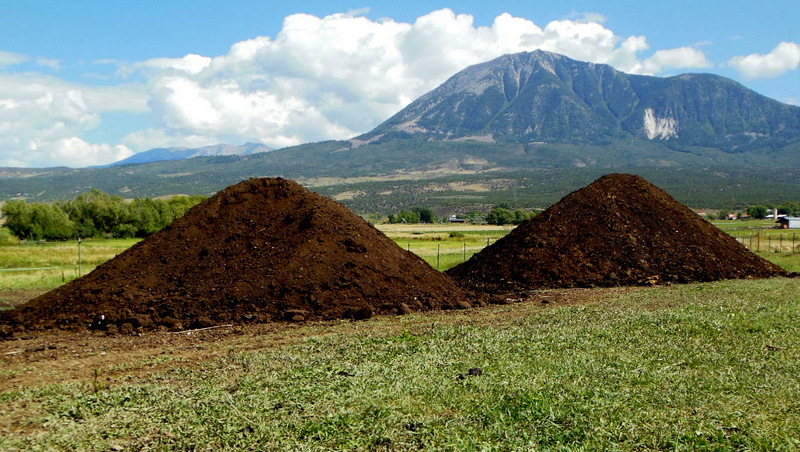Compost Magic
Compost is the cornerstone of the organic garden. Every organic gardener should learn how to make great compost. There are as many ways to make compost as there are gardeners. It is easy, cheap and convenient. If you are creating your own compost from the materials you find in your house and yard, this makes your food practically free. Your first few compost endeavors may not go as planned and each yard and mix of materials will be a little different. I challenge you to keep at it until you can compost anything the first time. Make this your personal challenge for the year. Earn the title Super Composter!
Compost is a great way to keep organic matter out of the landfills. Besides, why throw away perfectly good nutrients and then have to go buy some. With just a little knowledge and a few tools, you can make all the nutrient rich compost that your garden will need. I was watching Joel Salatin on YouTube the other day, and he said that if all the farm land in the world would add 1% organic matter to the soil, we could sequester all the carbon in the atmosphere that has been put there since the Industrial Revolution. Wow, think about this. If we make compost and put the organic matter in the soil, we are helping to reduce the global warming situation. This is even better than changing out our lightbulbs to reduce global warming.
Compost Container
 There are zillions of gadgets on the market for holding compost. For some people it will be easier to buy a ready made container than to make one. Compost tumblers are the easiest way to make compost fast. The tumblers range in price from $100 to $400. You can start small and work your way up to a bigger tumbler if you need. It is possible to make compost in a pile on the ground but it takes a lot more work, it is usually smelly and animals tend to dig in the ground piles unless you cage the pile. But, it is a free way to make compost.
There are zillions of gadgets on the market for holding compost. For some people it will be easier to buy a ready made container than to make one. Compost tumblers are the easiest way to make compost fast. The tumblers range in price from $100 to $400. You can start small and work your way up to a bigger tumbler if you need. It is possible to make compost in a pile on the ground but it takes a lot more work, it is usually smelly and animals tend to dig in the ground piles unless you cage the pile. But, it is a free way to make compost.
Easy Composting
If you do a search in the Internet about how to make compost, you are going to get a million different answers. Compost is hard to mess up – if you follow the rules, you can’t go wrong. Many different ingredients will work. There are very technical ways to make compost and there are simple ways. We will start with a simple recipe and if you want to perfect compost making, then go online and start reading. Here is the simple way. To make great compost the pile need 5 basic ingredients.
- It needs a source of carbon. This is called the brown stuff which includes dried grass, hay, shredded newspaper, dried leaves and sawdust. Leaves will add trace minerals (aka “flavor”) from deep in the ground. Do not add the leaves of black walnut, magnolia, hemlock, eucalyptus, juniper, pine, oleander. The carbon material is food for the good fungi.
- Compost needs a source of nitrogen: this includes kitchen scraps, fresh grass clippings, fresh plant scraps and manures. The nitrogen or “green” ingredients are food for the good bacteria. The manure of cats and dogs can be harmful to humans if composted, so leave them out. Egg shells are great, they add calcium. Coffee grounds are fine too.
- Compost needs adequate moisture. Not too wet and not to dry. The way to test if your compost is to wet or dry is to squeeze a hand full and if you can only get a drop of water to come out it is just right. If you can squeeze lots of water out it is too wet. If you get no water and your hand is dry then it needs water.
- Compost needs oxygen for the good microbes to breathe.
- You will need compost starter, which has microbes in it to inoculate your new pile. You can buy commercially made starter, which might be a good idea for the first batch. After that, you can use some already finished compost to activate your new pile.
Lack of water and oxygen are the main reasons why people fail to make compost. Be sure you have proper moisture and stir the pile twice a week. The smaller you chop the ingredients the faster it will compost. Try to get a balance of carbon, nitrogen and kitchen scraps. Then, add water and stir to get enough air. Put the carbon, nitrogen and kitchen waste in layers. Always cover the kitchen scraps to help keep the critters out.
Do the Ingredients Need to be Organic?
Everything that I put in my compost pile is organic. If you have pesticide or herbicides residues on the scraps that you put in the compost then you run the risk of harming the microbes and potentially harming the vegetables or yourself. I heard this story where the cows were eating feed that had herbicides in it. When the cows pooped, the poop killed the pasture grass. I do not want to put anything in my compost pile that could be dangerous. I will only use manure from animals that have been fed organically and had no GMO feeds. Also, I will not use any grass clippings that have been treated with chemical fertilizers or herbicides. One year our town was giving away truck loads of leaves that they vacuum up from the streets. I thought that would be a great way of getting some extra compost material. Not such a great deal. I got leaves but they came with beer cans, glass, and a dead cat. I decided not to put that mix in my compost pile. So be selective about what you are willing to put in your compost.
Composting Process
Here is basically what is happening in your composting process. The carbon and nitrogen materials are being converted into earth through the microbes. The good bacteria and fungi are breaking down the materials. The microbes need an environment that is conducive to their work and growth. The good bacteria and fungi need oxygen and moisture to do the conversion. The bacteria create the heat in the compost process. The heat is good because it can kill weed seeds and bad pathogens. The heat also helps the microbes to increase their population. If your compost is lacking in oxygen, then bad, anaerobic bacteria can grow and create a stink.
A good compost pile needs a carbon to nitrogen ratio of 25:1. You can get into some very complex equations to get this ratio right. We just need to get in to the ball park. For your “brown” stuff use leaves, dry grass or hay, sawdust or shredded black and white newspaper with soy ink.
For your “green” stuff use grass clippings, kitchen scraps (no meat or grease) or fresh plant material. A good ratio to get the carbon to nitrogen in the ball park is 1/2 brown stuff, 1/4 green stuff and 1/4 kitchen scraps, by volume. If you don’t have enough kitchen scraps, then use 1/4 more green stuff. Try not to make this too hard on yourself. If you get the recipe close, the microbes will do the work. You are looking for a pile at least 24-36 inches tall and wide.
 Put all the ingredients in your tumbler or in a pile. If it is moist enough, it should start to heat up within 24 hours. If it is not doing anything, then add a little water. The outside air temperature can have an effect on the start if it is below 40 degrees. If it is cold, give it a few more days. For your tumbler give it 5 turns every other day. For your pile turn it every other day and rotate the outside stuff to the inside. The compost should be done in 2-3 weeks.
Put all the ingredients in your tumbler or in a pile. If it is moist enough, it should start to heat up within 24 hours. If it is not doing anything, then add a little water. The outside air temperature can have an effect on the start if it is below 40 degrees. If it is cold, give it a few more days. For your tumbler give it 5 turns every other day. For your pile turn it every other day and rotate the outside stuff to the inside. The compost should be done in 2-3 weeks.
One way to test if your compost is done is by the smell. If it is ammonia smelling, then the bacteria have not finished their job and the compost needs to “cook” some more. Once the bacteria get finished, then the fungi really get going. Once the fungi are done, the compost will smell earthy. Then you know it is done. Another way to tell that it is done is when you can’t recognize the ingredients that went in to the pile. This compost is teeming with microbes that are perfect for your garden or lawn. This compost is also what you can use to make compost tea.
If you need to make compost now, get 3 bags of leaves or a bale of straw and a 50# bag of alfalfa meal or 3 bags of fresh grass clippings and start a pile. This should make compost in 2-3 weeks. It may take you several tries to get really good compost. If you get a funny pile, just start over. It is important to learn how to make good compost, and it is really easy once you figure it out.
I don’t know if you noticed but we are working with the same soil food web in the compost pile as we are in the garden. Mother Nature’s way of feeding her plants. This is a beautiful and simple system that can take care of your garden as long as you don’t harm the microbes with any chemicals.
An easy and cheap compost container is to get seven shipping pallets and wire them together. I like to use two compost bins at a time. One bin will hold the compost and the second bin will be used when the compost needs turning. You just take down one side from the full compost container and shovel the compost into the empty container. This aerates the pile and helps it to break down faster. No matter what you use for a container be sure that you can stir the pile.
How Much Compost Should I Put On The Garden?
Everyone wants to know how much compost or fertilizer to put on the garden. The fertilizer companies have their fancy ads on the TV telling you to buy this and that to make your garden great.
Let’s take a step back in time to see how fertilizing was done in the good old days, before fertilizer companies and TV. You find the richest, most fertile soils in the forests, why is that? Every year the forest floor gets a new layer of leaves and organic matter. The worms and microrganisms come along and digest the leaves, turning them into rich compost for the trees to feed upon. In the garden we should try to mimic nature, by making our own compost we are creating our own rich soil.
In my garden, I add about 1-2 inches of compost to each cinder block unit in the beginning of each growing season. The great thing about compost is you cannot burn the plants with it. If you get too much, the nutrients will just sit and wait until the plants need it. With a good compost heap you can sustain your garden forever. It reminds me of having a sourdough starter.
Compost for the Lawn
Compost is the perfect fertilizer for your lawn. Make an extra batch or two to feed the lawn and keep the chemicals out of your yard.
Here is a reference chart of how much carbon to nitrogen there are in some of the more common compost materials. Just use it as a reference; I would not spend the time to calculate out all the ingredients. Remember, if we get it close, then the microbes will be happy.
Compost Ingredients |
Compost Ingredients |
||
|---|---|---|---|
(no colored paper) |
|||
Compost Pile Items
The Good - Put These in Your Pile!- Alfalfa, sawdust (in small amounts)
- Animal fur, seaweed and kelp
- Vegetable and fruit scraps
- Shredded cardboard, shredded newspapers
- Aquarium plants
- Bird cage cleanings, feathers
- Guinea pig, gerbil cage cleanings
- Blood meal, bone meal, hoof and horn meal, fish bones, meal
- Tea bags and grounds, coffee grounds
- Bread crusts, cooked rice, egg shells
- Theater tickets, Kleenex tissues, envelopes, grocery receipts
- Paper napkins and towels, post-it notes
- Brown paper bags, burlap coffee bags
- Tofu, tossed salad
- Cattail reeds, clover, winter rye, straw, hay
- Vacuum cleaner bag contents, lint from clothes dryer
- Wood ashes (in small amounts)
- Cover crops, wood chips, grass clippings, leaves
- Dead bugs, worm castings
- Electric razor trimmings, hair, fingernail clippings
- Expired flowers, houseplant trimmings
- Farm animal manure
- Freezer-burned food (non-meat)
- Limestone, green sand
Compost Pile Items
The Bad - Don't Use These in Your Pile!- Cat or dog feces
- Human feces
- Meat or fat or bones
- Colored newspaper
- Pine needles
- Black walnut leaves
- Wax
- Plastic
- Weed seeds
- Dairy products
- Oak leaves
- Waxed cardboard
- Large pieces of wood
- Pesticide treated plant material
- Grease or oil
- Magnolia leaves
- Hemlock leaves
- Eucalyptus leaves
- Juniper leaves
- Pine leaves
- Oleander leaves
Now is your time to get your compost pile going. Go get some brown stuff, some green stuff and give it a whirl. If it doesn’t work out the first time try, try again until you get it. Each batch you will learn something new. Before you know it, you will be a compost superstar! It is well worth the time to learn this skill.
Download the article (pdf format).


